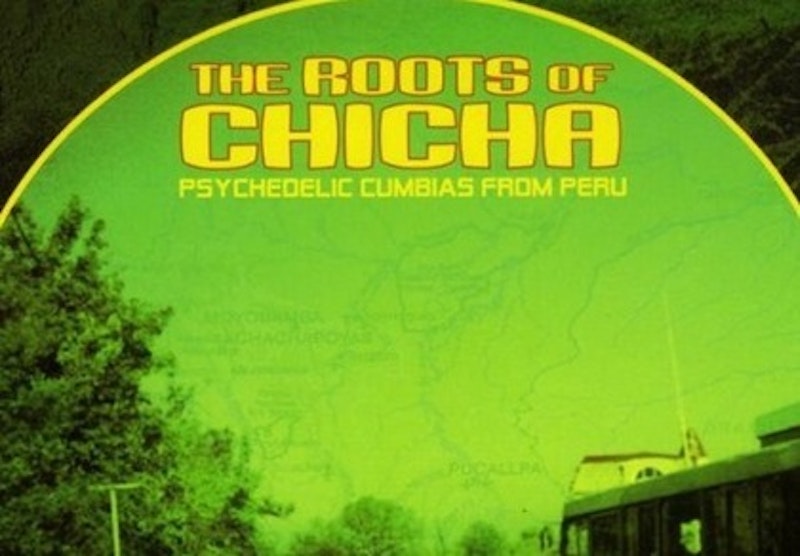I don’t live in the icy half of the country anymore but I feel your pain. I grew up and went to school on both sides of Lake Michigan where classes were cancelled simply because of “wind.” Heck, even last night here in Los Angeles it was 39 and raining and in the wet, nasty cold of this usually sun-baked place, all I could think of was how much I wanted to get somewhere warm and dry, sit in the sun and listen to some music.
Fortunately there’s a really hot tropical Afro-flavored disc I’ve just come across that is just about as good as taking a plane out of the concrete tundra and landing smack-dab in the welcomingly sweltering heat of the lush Amazon.
For a little tonal vacation, check out the totally swingin’, outlandishly spooky, disgustingly funky compilation The Roots of Chicha : Psychedelic Cumbias From Peru issued by Barbes Records out of Brooklyn.
To see what I mean about the funky spookiness, check out the first track of the album, Los Mirlos’s “Sonido Amazonico” which could have been taken out of a 1950’s Indian detective movie during the middle of a sweet chase scene.
It sets the tone immediately. When they say “psychedelic” on the album cover they mean it; this is tropical music on something. Everyone is playing fast and there’s so much stomping and clapping you can you can almost feel the sweat dripping down the player’s smiling faces. Though it never found an international audience like the more political Brazilian and Columbian tropical cumbia, chicha prospered in Peru because was dedicated to one sacred thing only: keeping the lower classes dancing.
For something a little more upbeat (and colorful, check out those costumes) try Los Hijos De Sol doing “Cariñito”
Olivier Conan has done a wonderful job compiling the right bands, tracks and tastefully erudite liner-note history to represent chicha’s most fertile decade – 1968-78 when the bands featured here like Los Hijos Del Sol, Los Mirlos, Juanecoo Y Su Combo and others became sensations in Peru practically overnight. While much of the western world was experimenting with drugs and new music, TV had finally brought western culture into the dark jungle towns of Peru giving them their own small-scale rock and roll revolution.
Originally named for the earthy alcoholic corn drink that mostly poor and uneducated Andeans have sipped for millennia, (chicha de jora), chicha or cumbia Amazonica usually features the combination of a raucous Afro-Cuban percussion corps (congas, bells, timbales, bongos) the echo-y electric guitars of American surf music, the crackly wah-wah pedals of island reggae, and the fuzzy bass and moody Farfisa organs of the British Invasion (pushing out the more traditional Latin accordion and acoustic mariachi style guitars)—all together making it a fragrant, genre-defying stew of many international musical styles.
Half of the tunes are upbeat instrumental dance jams with a healthy dose of humor: none more so than a only-slightly ridiculous and mostly awesome electric version of "Fur Elise" by Los Destellos which was fronted by Lima’s Enrique Delgado, perhaps the godfather of the fuzzy and manic electric guitar that chicha became famous for.
Many of the jams also double as hypersexual love songs, none more so than Juaneco Y Su Combo’s trippy bass-heavy nymphomaniac lullaby “Vacilando con Ayahuesca.” Juaneco’s band epitomized the melding of traditional and urban tropical music, going back and forth between the openly sexual and socially observant nature of modern rock and the cryptic poetry of their farmer forefathers. Conan writes that they claimed to be of Shipibo Indian stock and insisted on dressing in neon-bright traditional costumes even when they toured the glitzy urban centers of Brazil, Ecuador and Columbia throughout the 1970’s. Sadly, most of the group died in a plane crash in 1976.
I was amazed by some of the incredible vocal harmony work in the compilation as well. Often everyone in the band sings in unison, and when the musicians aren’t singing at the top of their lungs they are shouting or whistling or laughing or goading each other on, or coming on to you or banging on something. Certain slogans are repeated again and with relish such as “El Milagro Verde!” by Los Mirlos who were from the Amazon backwater Moyobomba and tried to immortalize its mysterious and magical lushness.
By the fifth listen this CD was hitting me like a revelation. Like many of my American peers, my everyday experience of Latino and Pan-African music mostly stops and starts with Manu Chao, or Amandou and Mariam, but it’s funny how easily we forget that the United States is only part of "American" culture.
Months after first listen I still have chicha on at all hours, playing it over and over no matter what the situation—in the car, at work, at the gym, at night. It’s a sound that, despite its intoxicating exoticness (close your eyes and you’re in the middle of a jungle village, not buying donuts at an L.A. strip mall) it’s also oddly reassuring and familiar to my western ear. It’s like discovering something you knew all along but didn’t know where it was or how you knew it.
The liner notes are chock-full of facts about chicha, something most of us rather ignorant gringos can be grateful for. “Bubbling out of the oil-boom cities of the Peruvian Amazon,” Olivier Conan writes, this talented and diverse groups of musicians, many from these urbanized ancient Andean settlements, mixed “the distinctive pentatonic scales of Andean melodies” with the more percussion-based dance-music of their native and African and West-Indian antecessors and added that pivotal urban western element, thanks to a flood of new technology.
The results, I promise you, are astonishing. Buy this CD.
For another choice in “Sonido Amazonico” go here.
Hot Amazon Folk-Funk to Warm You Up
The Roots of Chicha is the cure for wintertime blues.

